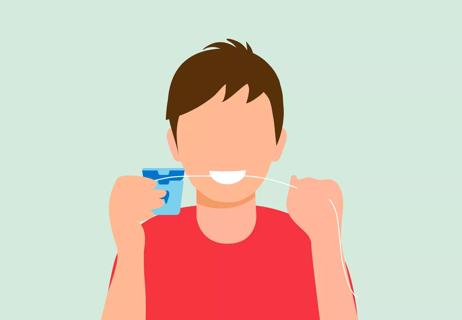Your toothbrush can’t reach the area where your teeth meet your gum line

You probably already know that you’re supposed to be brushing your teeth twice a day. But if you’re brushing without flossing, you’re not keeping your teeth as clean as you could be. Dental floss can get under your gum line in a way that the bristles on your toothbrush simply can’t.
Advertisement
Cleveland Clinic is a non-profit academic medical center. Advertising on our site helps support our mission. We do not endorse non-Cleveland Clinic products or services. Policy
“A lot of us have never really been shown how to properly brush and floss,” says periodontist Sasha Ross, DMD, MS. “So, just having your dentist or hygienist tell you to do it isn’t enough. You have to know how to do it.”
She walks you through the right way to floss, how often to do it and what can happen if you don’t.
First things first: You should be doing the majority of your flossing with string floss, the kind that you hold and wind around your fingers.
Those little plastic dental picks are OK in a pinch, like if you have something stuck between your teeth while you’re out to eat, but your regular flossing should be done the old-fashioned way. (The exception here, Dr. Ross says, is if you have hand dexterity issues. “If you have a disorder that keeps you from being able to grip the floss, picks are a good alternative,” she notes.)
“Studies have shown no difference in unwaxed or waxed floss,” Dr. Ross adds, “but I personally prefer unwaxed, as it seems to be a little bit more effective.” If you have braces, however, waxed floss may be a better choice, as it’s less likely to get stuck or torn than wax-free versions.
Here are the steps to flossing your teeth the right way:
Advertisement
Good oral health means more than just a nice, white smile. Oral health is linked to whole-body health, which means that problems with your teeth and gums can lead to other health concerns like heart disease, stroke and more.
“Flossing is incredibly important because studies have shown that brushing just doesn’t get to the area in between your teeth,” Dr. Ross states. “If you’re not getting the plaque there, it can lead to cavities or periodontal disease or both.”
Periodontal disease is associated with an increased risk of:
The American Dental Association recommends brushing your teeth at least twice a day and flossing at least once a day. Of course, if you feel like you’ve got a big ole leaf of spinach stuck between your chompers after lunch, there’s no need to wait!
And in this case, practice makes perfect. “If you’re initially struggling, don’t give up,” Dr. Ross says. “Look in the mirror when you’re doing it, and lean on your dentist, periodontist or hygienist for extra instruction, if you need it.”
To learn more on this topic from Dr. Ross, listen to the Health Essentials Podcast episode, “Keeping Your Mouth Healthy.” New episodes of the Health Essentials Podcast publish every Wednesday.
Advertisement
Learn more about our editorial process.
Advertisement

Estrogen and progesterone changes throughout the month — and throughout your life — can make you more prone to dental health concerns

Benefits typically include bi-annual screenings and lower payments on procedures like fillings and crowns

Once you see that first tooth, it’s time to start brushing

You can do damage to fillings, crowns and even your teeth themselves

Despite unfounded theories, fluoride has the power to make your teeth stronger

Studies show they do a better job than manual brushes at removing plaque and debris

This tool is an add-on to your regular brushing and flossing habits, not a replacement for them

Flossing first might be a tad more beneficial, but it’s most important that you DO brush and floss

Type 2 diabetes isn’t inevitable with these dietary changes

Applying a hot or cold compress can help with pain